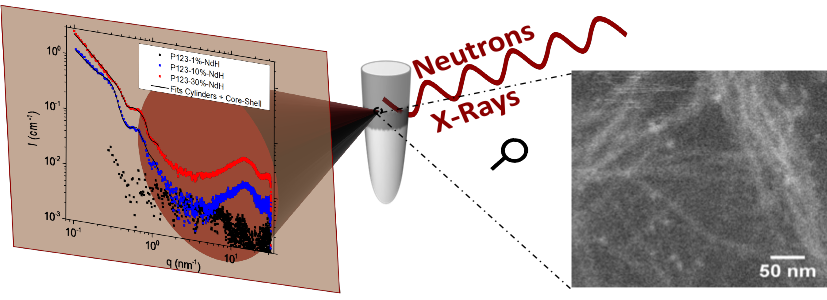
Publication in Colloids and Surfaces A: Physicochemical and Engineering Aspects (04/03/2024)
Teams LNAR/L2MEMicellar solutions can be used to treat wastewater containing cationic elements that need to be recovered either for reclamation or for immobilization on solids in a decontamination process. The technique developed by our team uses a poorly water-soluble organic ligand that migrates to the hydrophobic core of micelles when complexed with the cationic element. The migration of this complex towards the micelle core leads to the formation of mixtures of colloidal self-assemblies that are difficult to characterize.
The morphology of complex micellar assemblies is usually described using indirect methods such as small-angle X-ray scattering (SAXS) or small-angle neutron scattering (SANS), which can lead to ambiguous descriptions of the nano-objects when the sample contains multiple or totally unknown structures. Here we propose to overcome this limitation and directly observe nano-objects formed in solutions of Pluronic P123 with and without REE/HDEHP complex using wet scanning transmission electron microscopy (wet-STEM) and compare the results with sample descriptions derived from SAXS and SANS measurements.

Credit: J. Causse / ICSM
The results obtained by the different analytical techniques are consistent. Each analytical method provides complementary information. SANS enables fine characterization of P123 micelles thanks to the high contrast between hydrogenated surfactants and deuterated solvent, SAXS enables characterization of REE/HDEHP complexes thanks to the high electron density of REEs, and Wet-STEM enables direct visualization of the mixture in solution.
The compilation of this complementary information provides a detailed description of the internal structure of the objects, their compositions and their mutual interactions. The main contributions of Wet-STEM microscopy are to describe nano-objects individually and, in particular, to show that the REE content can vary from 1 to 10 from one micelle to another, to observe the dynamics of nano-objects in the liquid and thus prove the coexistence of very different morphologies in the same system.
For more information, read the articles :
[1] Characterization of complex micellar systems by Scattering techniques (SAXS and SANS) and wet-scanning transmission electron microscopy (wet-STEM). J. Causse, C. Lavaud, J. Ravaux, J. Lautru, R. Podor. Colloids and Surfaces A: Physicochemical and Engineering Aspects 682 (2024), 132928. DOI: 10.1016/j.colsurfa.2023.132928
[2] Simultaneous lanthanides and surfactants micelles removal from aqueous outflows by complexation and sol-gel chemistry. C. Lavaud, F. Goettmann, A. Grandjean, J. Causse. Separation and Purification Technology 145 (2015), 17–23. DOI: 10.1016/j.seppur.2015.02.047